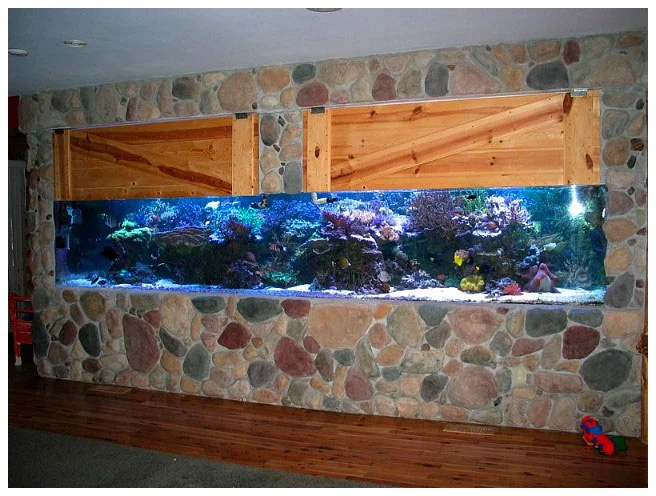Stunning 2100-Gallon Reef Tank by Stanley Genadek | ReefKeeping

Tank Specifications
Volume: 2100 Gallons / 7939 Liters
Dimensions (L × W × H):
15.5" ×
5.0" ×
33.0"
473.4cm ×
152.4cm ×
83.8cm
Equipment List
No equipment information available
Frequently Asked Questions
How do I create a natural-looking aquascape for my reef tank?
To create a natural-looking aquascape, consider using a PVC frame as the base structure. Use eggcrate to form shelves for your live rock, and conceal the framework with materials like Great Stuff™ foam. After curing, you can apply an epoxy resin mixed with fine aragonite sand to make it look like live rock. Arrange the live rock to create open areas and hiding spots to mimic natural reef environments.
What are effective techniques for maximizing swimming space in a reef tank?
Maximizing swimming space involves vertical aquascaping. Build height with your rock formations rather than spread them out across the bottom. Create caves and alleys within the structure that allow fish to swim behind rocks and emerge at different points, emulating natural reef habitats.
What type of protein skimmer should I use for a large reef aquarium?
For a large reef aquarium, consider using high-efficiency protein skimmers such as the Volcano skimmer, which has a significant body capacity and draws minimal power. Look for models that efficiently remove organic waste and help maintain optimal water quality.
How can I automate the maintenance of a large reef tank?
You can automate maintenance by integrating equipment such as automatic water changers, dosers for calcium and alkalinity, and a reliable skimmer that requires minimal intervention. Ensure that your system is capable of operation without daily oversight, and utilize timers and controllers for lighting and temperature regulation.
What are some effective methods to control temperature fluctuations in a reef tank?
To control temperature, you can use multiple strategies: install inline heat exchangers that use cold water to cool tank water, utilize fans for convection cooling, and maintain a temperature-controlled RO/DI water storage tank. Additionally, you may use a thermostat to manage your home’s furnace based on tank heating needs.
What type of lighting is best for a mixed reef aquarium?
For a mixed reef aquarium, a combination of metal halide lights (250W and 400W) is effective. Use higher wattage bulbs for deeper areas and lower wattage for the upper regions. This ensures sufficient light penetration for both stony and soft corals. Utilize reflectors like Lumenarc for optimal distribution of light.
How can I ensure a balanced ecosystem of fish and corals in my reef tank?
To ensure a balanced ecosystem, select a variety of both fish and coral species that complement each other's needs. Introduce soft corals and stony corals strategically to keep color variation and movement. Aim for a mix of unique and rare fish to enhance biodiversity. Monitor interactions to ensure compatibility among species.
What types of fish work well in a large mixed reef tank?
In a large mixed reef tank, consider species such as Snowcap clownfish, Gem tangs, and various wrasses. Ensure that the fish you choose have compatible temperaments and dietary needs. Keeping a balance between small and large species can help maintain a dynamic and visually appealing aquarium.